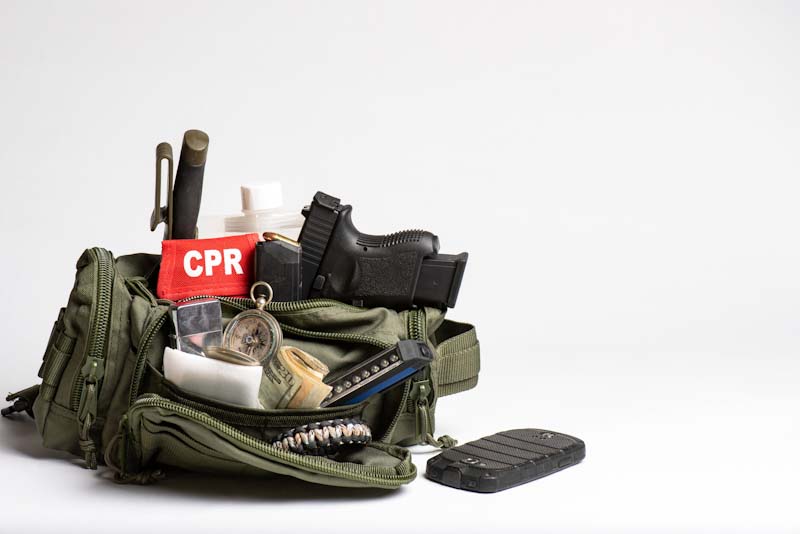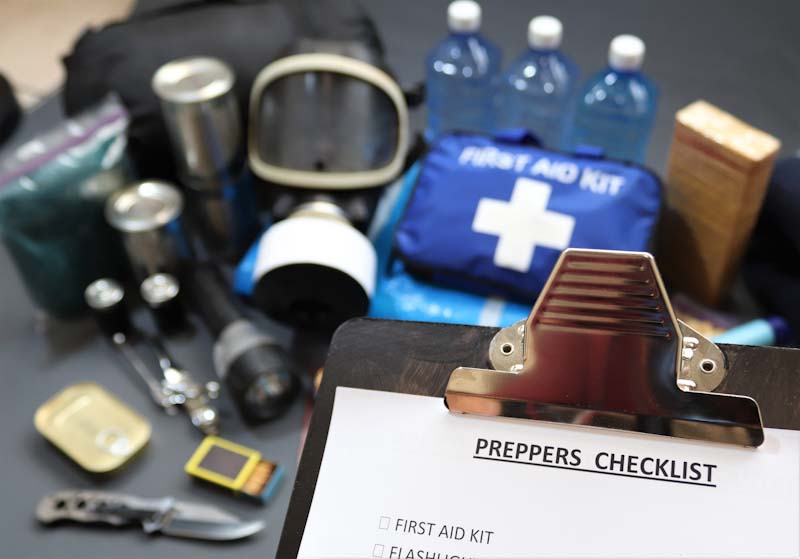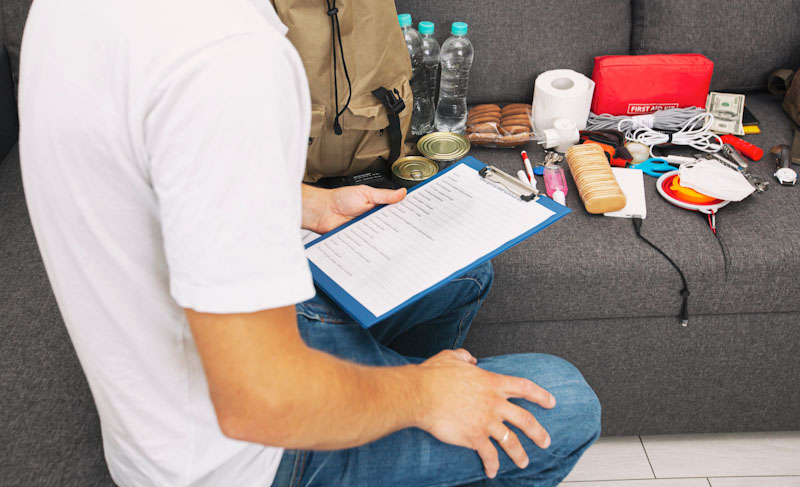Planning, but most importantly, effective planning, is one of the basics of emergency preparedness since it will guide you through each task you need to complete in order to survive.
Planning provides you with the means and tools to act ahead of time and will make sure you are prepared to handle the survival situation you’ve prepared for. However, planning is not always enough, especially if you’re survival plan includes a bugging-out scenario.
I advise every prepper out there to give themselves time to sit and plan things through and envision the various scenarios they may one day expect to face. However, I also tell them that planning is only half the job and there’s more to be done.
The unexpected factor
Every survival plan, regardless of where you live or what you are prepping for, has the unexpected factor we should always consider. Each plan has unique needs and challenges, and I believe the bugging-out scenario has the most variables of all scenarios when it comes to its success rate.
For example, you will be traveling to or traversing unknown territories, and you should always think about the unexpected. You may have planned a route out of town, but that route might be blocked by a landslide or social upheaval. In this case, it’s important to map out alternative routes, even if some may involve a long detour.
If you have to camp while bugging out and you know how to do so in dry weather, you better plan how to function and accomplish the task in wet or winter weather. For example, starting a fire in bad weather is much more challenging than in dry weather, and you have to make sure you can keep the fire protected, but also how to keep the firewood dry and in reach without exposing yourself to the elements.
You may be able to endure longer car trips than others, and you might even enjoy them, but how about your elder parents or your children? How will they handle the situation? Will you be able to keep them safe and content?
These are just a few examples of the actual scenarios you may have to face and a clear example of how unexpected scenarios/factors can affect our bug-out plans. It’s up to you to draw the outcomes of possible scenarios and include in your plans the unexpected factors.
When I make a plan for a certain scenario, regardless if I plan to go camping or if I prepare for my neighborhood to blow up with discontent during the next election, I always put everything on paper. I do this for two reasons, and I encourage you to do the same.
The first is that writing things down can help me memorize everything better (this is actually a proven thing), and the second is that having my plans on paper helps me access them whenever I want and make changes as I see fit.
I also share these plans with my family and close friends since everyone will be able to get on board, and they will know what to do when I’m not around, but also to obtain their input. Having them state their opinions and concerns not only helps me prepare better and adjust my plans but also helps me discover unexpected setbacks or problems that I didn’t initially consider.
Here is a quick example, if you have kids and toddlers in your family, they might be totally dependent on you during a survival scenario. However, if you have teenagers or young adults in your family, they can help with a multitude of tasks during the same survival scenario, thus increasing your chances of success.
You can’t plan for one of your family members to drive a car if he or she is a bad driver and/or can’t handle stressful situations. I mean, you can plan for it, but don’t expect the results you’re envisioning. Consider everyone’s strengths and weaknesses and plan to work with each of these in both expected and unexpected situations.
Learn from your mistakes
My grandfather used to say that you should learn not only from your mistakes but also from your successes. And there’s no learning curve to any of those cases and no options to do so unless you practice and test your plans.
The problem with most bugging-out plans is that few people actually invest their time and energy into testing what they’ve put on paper. They don’t even know how to do so, and they leave it all to the planning stage, hoping that everything will turn out fine when they need to execute these plans.
What I’ve been doing for years is to pretend and act like the scenarios I’ve prepared for have happened. I’ve often turned weekends and vacation weeks into bug-out trips just to see what I’m doing right or wrong and how everyone is able to cope with the situation.
I take notes after each experience, and I modify the plans as needed. Nothing will tell you how well or bad you’re doing like these pretend drills, and I guarantee you will encounter many unexpected factors you’ve never even considered.
Getting out of dodge
One of the first things every bug-out plan needs to include is a strategy to get everyone together and put everything you need in your bug-out vehicle.
Putting everything in your vehicle is a rather easy task and will help you figure out if everything will actually fit in your vehicle. Perhaps you’ve planned to carry more items than you actually need, or perhaps there won’t be enough room for your stuff and all the family members and pets. Only by putting everything and everyone together will you be able to figure this out.
The more complicated part is bringing everyone together. What will you do when your kids are not at home? How will you reach your parents if they are not at home when the brown stuff hits the fan? Do you know about the whereabouts of your family members? Do you know what they like to do in their free time, and are you familiar with all the places they like to visit?
You should plan for meeting points, and you must make sure you are able to contact every one and bring them together when you need to get out of dodge.
Now, once you have everyone together and all your gear packed, it’s time to head out to your safe heaven (bug-out location). I advise you to plan the trip at various times of the day, week, month and year, both during rush hour and when there’s no traffic; both during holidays or events when the neighborhood/city may be packed or deserted.
If you do so, you will figure out how much time you need in order to get out of town. Since you have the time estimations for both light and heavy traffic, now add into the equation a natural disaster like a hurricane or wildfire that can double the “exit time”. Check online and investigate past traffic jams in your region, the events that caused them, and what the outcome was.
Once you’re on the road, map the places that you’ve planned to visit to acquire gas, provision, and medical supplies. If you test your bug-out plan on multiple occasions, you will discover that some may still be there while others will not. Not to mention that new locations may pop up on both your main and secondary routes, and it is best to map these as well.
Simulating a bug-out scenario as often as you can also help you discover the unexpected factors of a vehicle failure or the improper use of the vehicle on various terrain and during various weather conditions.
You may need to change a flat tire, and this not only will it help you figure out how much your trip may be delayed but also how well you can handle the task during good or bad weather, and if others besides you can do it and so on.
You may need to stop on the side of the road, or perhaps (depending on the scenario) you might have to find a safer area to change the tire. Can you do so without unpacking everything you packed at home, and do you have every tool you need in reach? You can imagine that setting everything out in the rain just to teach the spare tire or the tools you need is far from ideal.
Perhaps you will figure out that you can’t handle basic vehicle maintenance, such as adding coolant or motor oil, and if and when your vehicle breaks down, you should be able to handle the next stage of your bug-out plan.
Going on foot
Simulating a bug-out scenario also requires simulating having to go on foot since you never know when your vehicle may become unavailable, and you need to ditch it to continue your journey.
If you plan on doing so, don’t abandon your vehicle with everything you’ve packed still inside. If you do so, you risk having your stuff stolen since an unguarded vehicle is an easy target. Instead, drive to your bug-out location, unload everything and go back as much as you feel comfortable, and try to continue on foot.
I usually get back a few miles short of my destination to test my abilities to go on foot carrying my bug-out bag. See how well you and the members of your group can handle the weight of the bags during good and bad weather, but also on various types of terrain.
Nothing will tell you how well you packed your bag and if you’re in good shape or not, like carrying your backpack for a few miles. A backpack with a weight of 25 to 50 pounds can really test your physical condition, especially if you walk through rough terrain or snow.
Not to mention that your feet will also tell you if the footwear you’ve picked for this journey are a good fit or not for the distance you need to cover and the load you need to carry. Bad feet will incapacitate even the most perseverant of survivalists.
Testing your skills
Testing your bug-out plan is not over when you reach your destination, and there are still a lot of things you need to put to the test once you reach your bug-out location. Here all depends on what your safe heaven is, where it is located and what resources it provides.
Even so, you should test all your basic skills like making a fire, collecting firewood, collecting and purifying water, but also cooking with the food, fuel, and utensils you have available. If you don’t have a cabin waiting for you, how about building a shelter from natural materials that would accommodate everyone and ditching the tents? Do you know how to plan such a shelter and what materials to use to build it?
How about simulating an injury to practice first aid and trauma methods? Not only will this help you improve your skills, but it will also help you discover how everyone else will handle the situation. Act like you’re hurt and take a few days off. Is everyone else ready to take on your tasks? Are they able to function and complete chores without your help and just by following verbal or written instructions?
There are many things you can put to the test once you reach your bug-out location, and it depends on everyone’s personal case and overall situation. What I can tell you is that if you do test your abilities to complete various tasks, you will build confidence and learn from both your failures and successes.
Updating your bug-out plan
Hopefully, you’ve tested your bug-out plan, and things went according to plan, or perhaps you’ve failed miserably. Don’t despair and don’t give up, but rather update your plans and be better prepared the next time.
Once you’ve made it through your emergency preparedness exercise, in one way or the other, you should be able to look at your plans with a fresh mind. Go over everything you wrote down and modify your plans and notes based on what worked or didn’t work during the testing phase.
Get everyone involved and compare notes to see what needs to be changed or improved. Perhaps you discovered a medical facility on one of your alternative routes that need to be added to your list of medical facilities. Perhaps you discovered that your kids could handle certain tasks better than you expected, and for other tasks, they may need your involvement and encouragement. Think of how you can exploit those strengths and weaknesses.
Figure out how your pets fit inside your bug-out plan and if you need to make special arguments for them since the test phase turned out to be a bad experience for both you and them. Look out for lightweight gear that could replace your old gear and make your life easier if you are forced to carry it around over long distances.
The list can go on and on, and everyone will discover new things about their plans and their abilities to handle certain situations. It’s a never-ending learning experience, and the more you put things to the test, the more you will learn.
Concluding
If you want to become a prepper or if you are a concerned family man that wants to keep the family safe, planning is never enough. You always have to put things to the test because that’s the only way you will be able to learn from your mistakes and successes.
Bugging out is a scenario that needs constant testing because there are many things that can go wrong, and there are various unexpected issues that may appear, even when you think you’ve got it all figured out. You may never completely eliminate the unexpected factor, but you may narrow down the list if you test your bug-out plan.








Robert | October 5, 2022
|
It’s a great idea to practice your bugout plan. Thanks for the article.
Armin | October 6, 2022
|
We’ve all been camping out in the “wild” at some point in our lives and it’s a lot of fun because we know that at the end of the week or two weeks we’ll be able to go back to our comfortable homes. I think in many ways that the people have the same romantic ideas about bugging out. Unfortunately in a true SHTF situation a few hundred million people will have the same idea. The idea of being in some idyllic location in the woods by yourself being in harmony with the deer is not going to be the reality. Wherever you go to bug out, unless it’s in a location so remote and inhospitable that NO ONE else wants to be there either, there will already be people there or are on their way there. And if you have picked out a location that’s so inhospitable what’s the use of going there in the first place. You want your bug out location to increase your chances of survival not decrease them. So you’re going to end up in the woods with a whole bunch other people hunting and fishing and cutting the trees down for firewood. It has to organized in such a manner that all those people in the woods hunting each other become part of a tribal structure. Local and regional warlords WILL arise. Not all will be just and fair. And so the cycle starts all over again. If your tribe is doing really well another tribe might be jealous and try to conquer your tribe. And conversely once the area you’re living in is unable to support the number of people (sex won’t go away and with sex come children) then a part of your tribe has to break away and find somewhere else to live or the splinter faction can combine with other tribes and try to conquer another tribe. One with a goodly number of resources to steal. And then once again we’re on the road to nation building. Expand. Kill. Conquer.